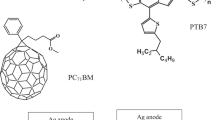Abstract
An inexpensive material, i.e., tetranuclear zinc(II) complex, (Zn4O(AID)6) [AID = 7-azaindolate], was utilized as a cathode buffer in organic photovoltaic (OPV) devices, leading to the improvement of device performance. Compared to OPV devices based on a conventional cathode buffer of TPBi (1,3,5-tris(2-N-phenylbenzimidazolyl)benzene), although the freshly prepared devices showed similar performance, when heated to a series of high temperatures under air, the short circuit current and the open circuit voltage of the Zn4O(AID)6 devices dropped more slowly, indicating the superiority of using Zn4O(AID)6 as a cathode buffer over TPBi in OPV devices.
Similar content being viewed by others
References
Peumans P, Yakimov A, Forrest SR. Small molecular weight organic thin-film photodetectors and solar cells. J Appl Phys, 2003, 93: 3693–3723
Yu G, Gao J, Hummelen JC, Wudl F, Heeger AJ. Polymer photovoltaic cells: Enhanced efficiencies via a network of internal donor-acceptor heterojunctions. Science, 1995, 270: 1789–1791
Heliatek achieves new world record for organic solar cells with certified 9. 8% cell efficiency. http://www.heliatek.com/?p=1346&lang=en. 2012-01-17
He Z, Zhang C, Xu X, Zhang L, Huang L, Chen J, Wu H, Cao Y. Largely enhanced efficiency with a PFN/Al bilayer cathode in high efficiency bulk heterojunction photovoltaic cells with a low bandgap polycarbazole donor. Adv Mater, 2011, 23: 3086–3089
Hong ZR, Huang ZH, Zeng XT. Utilization of copper phthalocyanine and bathocuproine as an electron transport layer in photovoltaic cells with copper phthalocyanine/buckminsterfullerene heterojunctions: Thickness effects on PV performances. Thin Solid Films, 2007, 515: 3019–3024
Peumans P, Bulovié V, Forrest SR. Efficient photon harvesting at high optical intensities in ultrathinorganic double-heterostructure photovoltaic diodes. Appl Phys Lett, 2000, 76: 2650–2652
Vogel M, Doka S, Breyer Ch, Lux-Steiner MCh, Fostiropoulos K. On the function of a bathocuproine buffer layer in organic photovoltaic cells. Appl Phys Lett, 2006, 89: 163501-1–163501-3
Yook KS, Jeon SO, Kim OY, Lee JY. Thermally stable organic solar cells using small molecule exciton blocking layer. Electrochem Solid-State Lett, 2011, 14: B59–B62
Song QL, Li FY, Yang H, Wu HR, Wang XZ, Zhou W, Zhao JM, Ding XM, Huang CH, Hou XY. Small-molecule organic solar cells with improved stability. Chem Phys Lett, 2005, 416: 42–46
Chan MY, Lee CS, Lai SL, Fung MK, Wong FL, Sun HY, Lau K M, Lee ST. Efficient organic photovoltaic devices using a combination of exciton blocking layer and anodic buffer layer. J Appl Phys, 2006, 100: 094506-1–094506-3
Yu J, Wang N, Zang Y, Jiang Y. Organic photovoltaic cells based on TPBi as a cathode buffer layer. Sol Energy Mater Sol Cells, 2011, 95: 664–668
Wang N, Yu J, Zang Y, Huang J, Jiang Y. Effect of buffer layers on the performance of organic photovoltaic cells based on copper phthalocyanine and C60. Sol Energy Mater Sol Cells, 2010, 94: 263–266
Shi J, Tang CW, Chen CH. US Patent, 1997. No. 564548
Ma Y, Lai T, Wu Y. A ligand-stabilized tetrameric zinc(II) cluster with high-efficiency emission from both singlet and triplet excited states for electroluminescent devices. Adv Mater, 2000, 12: 433–436
Lee C-F, Chin K-F, Peng S-M, Che C-M. A luminescent tetrameric zinc(II) complex containing the 7-azaindolate ligand photophysical properties and crystal structure. J Chem Soc Dalton Trans, 1993, 467-470
Gao ZQ, Mi BX, Xu GZ, Wan YQ, Gong ML, Cheahab KW, Chen CH. An organic p-type dopant with high thermal stability for an organic semiconductor. Chem Commun, 2008, 117-119
Rand BP, Li J, Xue J, Holmes RJ, Thompson ME, Forrest SR. Organic double-heterostructure photovoltaic cells employing thick tris(acetylacetonato)ruthenium(III) exciton-blocking layers. Adv Mater, 2005, 17: 2714–2718
Song QL, Li CM, Wang ML, Sun XY, Hou XY. Role of buffer in organic solar cells using C60 as an acceptor. Appl Phys Lett, 2007, 90: 071109-1–071109-3
Kageyama H, Kajii H, Ohmori Y, Shirota Y. MoO3 as a cathode buffer layer material for the improvement of planar pn-heterojunction organic solar cell performance. Appl Phys Express, 2011, 4: 032301-1–032301-3
Tao Y, Yang C, Qin J. Organic host materials for phosphorescent organic light-emitting diodes. Chem Soc Rev, 2011, 40: 2943–2970
Peumans P, Forrest SR. Very-high-efficiency double-heterostructure copper phthalocyanine/C60 photovoltaic cells. Appl Phys Lett, 2001, 79: 126–128
Ahlswede E, Hanisch J, Powall M. Comparative study of the influence of LiF, NaF, and KF on the performance of polymer bulk heterojunction solar cells. Appl Phys Lett, 2007, 90: 163504-1–163504-3
Author information
Authors and Affiliations
Corresponding authors
Rights and permissions
About this article
Cite this article
Li, Z., Gao, Z., Wang, H. et al. A thermal stable cathode buffer based on an inexpensive tetranuclear zinc(II) complex for organic photovoltaic devices. Sci. China Chem. 55, 2562–2566 (2012). https://doi.org/10.1007/s11426-012-4704-9
Received:
Accepted:
Published:
Issue Date:
DOI: https://doi.org/10.1007/s11426-012-4704-9




